Antwerpen and the IMMC
In Philadelphia, born and raised
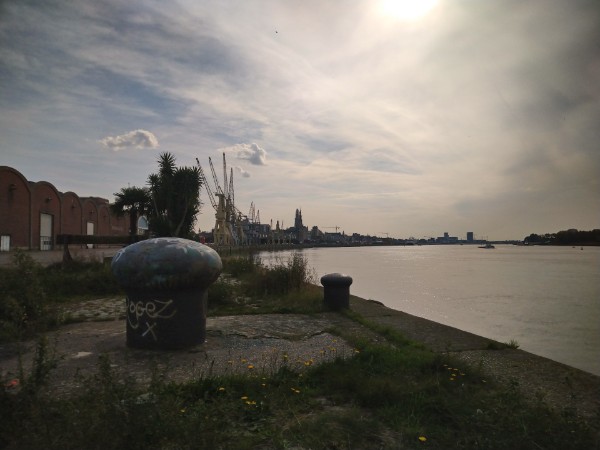
The quay from which the Belgian immigrants left Antwerp for the new world, sailing on ships of the Red Star Line and also Canadian Pacific. The large boulder you can see in front was especially placed to hold the moorings for their largest ship, the Belgenland, who started service in 1923.
In 1872, a group of investors from Philadelphia, USA, founded a company under the name of Société Anonymé de Navigation Belge-Americaine, a part of the Philadelphia Steam Navigation Company, which name was almost immidiately altered to International Navigation Company after founding the new company. They followed swiftly in the footsteps of the Pennsylvanian Railroad Company who had just started a transatlantic passengerline under the name of American Line, supposed to operate a connection between Philadelphia and Liverpool. As seen in the name, the INC was going to focus on Belgium where they hoped to attract passengers from the middle of Europe. Note: not really Belgium. What INC and especially its founder Clement Griscom understood was that American flagged ships were expensive and it was way better to have the ships sailing under the much cheaper Belgian flag. American Line did the opposite and they had their ships sailing under American flag, which imidiately gave problems in financials. Boldly, INC chartered two ships which they firstly employed on exactly the same route as the American Line, but then thus cheaper. So already one year later, Griscom took over the management of the American Line and the two lines started to work closely together. American Line was going to concentrate on the Liverpool run and the Société Anonymé de Navigation Belge-Americaine was concentrating on Antwerp in Belgium. Phew, what a name... Luckily, they use a red star in their flag and on their funnels, let's just name them the Red Star Line, like everyone else.
The first truly Red Star Line owned ships were kinda odd as Vaderland and Nederland were truly meant for the trading of petrol, which came from America. So they were in fact tankers, but because Belgium had not much to trade back, the only 'product' that seemed profitable on the westward journey were lifestock. People. So in fact, they were tankers with passenger accomodations. Now, that would be kinda hard to sell...
The worlds biggest company
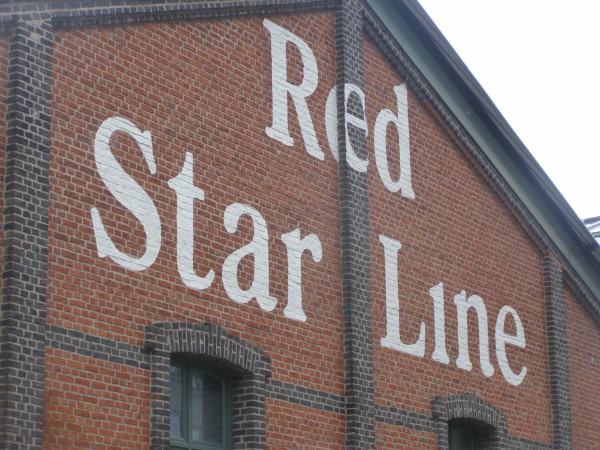
'Yeah, so we have two tankers that can sail with 570 passengers and another ship named Russland that can sail with 20 first-class passengers! We are goin' to be the biggest shipping company in the world!' A never-said quote from the Red Star Line offices. But strangely true in some way. Nobody would ever name Red Star Line as the biggest shippingcompany in the world. In their whole period of operations, between 1873 and 1939 they operated 'just' 24 vessels under ownership of which the largest one measured some 27.000-tons. But it was in fact the basis for indeed the largest shippingcompany that had ever exsisted. In 1873, IMC or the Red Star Line, took over the management of the American Line. In 1884, after the American Line had entered severe financial difficulties, the IMC bought the company outright and two years later, in 1886, they also bought the financially questionable Inman Line, a well-known British-flagged name in transatlantic travel that had been founded in 1850. Because of the significance of this aquisition, Inman was a large company at the time, the owning company changed its own name afterwards into Inman & International Steamship Company, which was split into two companies in 1892. The International Navigation Company of New Jersey which was the American branch for Red Star Line and American Line, and the International Navigation Company of Liverpool, which was the British branch for Inman Line. It still was one company, though. In modern day, you could make the comparissement with Carnival Corporation, for example. Started out as a small, insignificant cruisecompany which after a few large aquisitions became the most influential. Carnival bought P&O Princess in Britain in 2003 (a little like the Inman purchase) and this part of the Corporation became Carnival UK (Plc) with its own registration and owning companies beneath. Strangely, also Carnival Cruise Lines was founded exactly 100 years after the IMC, 1972 opposite 1872. Just a weird coincidence. Both of the INC's now started also to shift ships between their groups, exacly like Carnival is doing also. In 1902, to gain more capital, the American branch had changed its name into the International Merchantile Marine Corporation, backed by the American banker John Pierpont Morgan who imidiately increased the company's capital from 3 million dollars to 24 million dollars. Also, he bought shares in several other lines. By may 1902, the company that had originated from the smallish Red Star Line and its owners, owned the Red Star Line, American Line, Atlantic Transport Line (including the National Line), Dominion Line, Frederik Leyland Ltd. and even the huge White Star Line, their now most valued asset. With White Star having the agreement with the Northern Irish wharf Harland & Wolff that all the companies ships were going to be built there, also this wharf became tied to the combine, giving another problem to the Brits. The IMMC now concentrated solely on the North Atlantic and other lines were sold or ended, with the exception of White Star's Australian services. With this many lines and this many possibilities, the IMMC now was able to dictate the prices and other companies had to join, work together of adjust theirs.
The Belgian sculpter Carla Kamphuis-Meijer created this statue in honour of the Jewish people who were searching for a better life in the United States. It was inspired by the works of Eugeen van Mieghem.
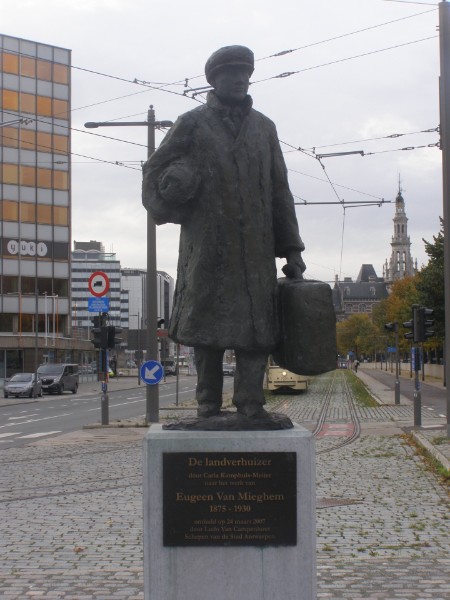
The International Merchantile Marine Corporation
The IMMC started to work together with the massive German companies Norddeutscher Lloyd and HAPAG, using a profit-sharing relationship. At that time, the German companies, together with the IMMC, strongly held a monopoly on the North Atlantic and this greatly concerned especialy the Brits, who had already lost the Inman Line and White Star Line. Especially triggered by the fact the Cunard Line could be going next, the Cunard board presured the British government to grand them huge subsidies and cheap loans to be able to built their two greyhounds Lusitania and Mauretania with the promise that the company then would stay British and out of hands of the American-German combine. Also, the government insisted that the ships would be able te be required as battle-cruisers for the Royal Navy when the need for that should arise and that could only be done with British-flagged and British-owned ships. Of course the world was slowly building up with tensions between the former allies Great Britain and Prussia (Germany) towards the Great War and those tensions also made the aquisitions of more British-based companies a huge concern. It wasn't really the central thought back then that America would help the Brits out in a period of crisis, like today, as ties between Germany and America were very strong at those years before the Great War and America could easily choose the other side to fight the Brits using their 'own ships'.
In 1912, the flagship of the IMMC fleet sank when the 45.000-ton Titanic perished on her first commercial voyage with a huge cost of life. Maybe a far-fetched comparissement again with modern times, when we compare the Titanic disaster to the Costa Concordia 2012 disaster, with Costa Cruises being one of the Carnival Corporation's most valued lines nowadays. Again a coincidence, as that there is again exactly 100 years in between. Both of these disasters had big consequences for passengertravel at sea and after the Costa Concordia disaster, many ports and regions started to question the impact modern cruising has on communities and the environment. Not the same, but comparable at least and writing this, the continuation of these 100-years intervals make me a bit chilly...
The Great War started in 1914 and with the IMMC having several financial problems, this came at kinda the right time for them. J.P. Morgan had put a lot of money in the company and the combine did not really delivered well enough to justify. The main reason IMMC was backed up by Morgan was that he wanted to combine the European railroads and the American railroads, making a huge world-wide network in travels. Not only by sea, but also by land. Morgan had built up its power mostly by investing in railroads in the USA, which then were a huge part of the American industrial revolution.
In 1915, IMMC's financial problems were so ginormous that the company went into recievership and was taken over by the former president of the American Transport Line, Philip Franklin. Under his management, the company survived the Great War and in the 1920's Franklin negotiated for loans from the American government to built ships in the United States and have them sail under the US flag. In 1926, he sold White Star Line to the British-based Royal Mail Steam Packet Company and it was later picked up by Cunard Line in the 1930's when they were merged in the days before World War II. Losing their most valuable company, the IMMC's fleet was greatly reduced during those years. In 1930, they just had 30 vessels left, in 1933 this dropped to 19 and in 1935, IMMC was down to just 11 ships and their reign over the oceans was over.
These are not the Red Star Line offices, these are the buildings which housed the medical facilities in which the immigrants recieved their checks. This was done to avoid huge costs as the immigrants who were described as being sick were denied entry into the United States and had to be taken back by the company who brought them at their own costs. The buildings now are the home for the Red Star Line Museum, sadly closed on the day I was at Antwerp. But I will go there soon and add pictures from the museum on this page. The look-out tower is placed as a beken, where in yesteryear a huge chimney was placed.
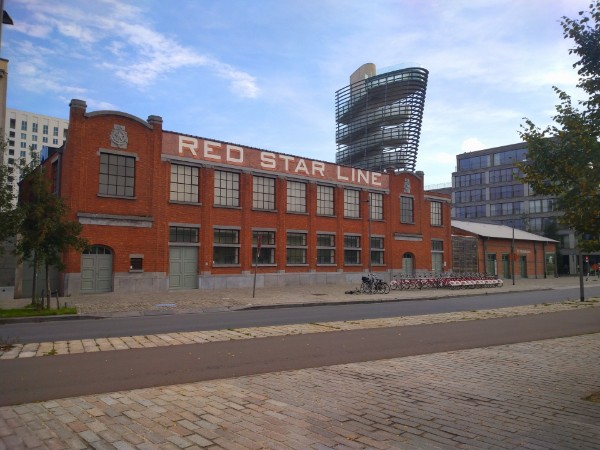
And so where is Red Star Line again?
I did not forget about those, but the IMMC history is basicly that of the Red Star Line too, as they were the original foundation on which the IMMC was built. One of the things changing at Red Star Line when Morgan took over in 1902 was their American base that was changed from Philadelphia to New York as Philadelphia clearly was not up to speed with the huge metropolis to the north. But due to ship shuffles and the lack of truly imposing Belgian-flagged liners, most of the middle Europeans were drawn to the larger and faster ships of the IMMC buddies Norddeutscher Lloyd and HAPAG, as well as the Holland America Line from Rotterdam. The latter was not really sure about the IMMC as they really wanted to stay independent, but they did also entered the IMMC for a bit as Lord Pirie, the owner of Harland & Wolff, had bought a controlling 51% of the Holland America Line shares around the same time the IMMC was started. Subsequentially, Pirie also sold a part of his shares in Holland America Line to HAPAG, resulting in the fact that the British were not keen in doing business with the 'German Holland America Line' in the Great War! In the 1930's, HAL bought back their stock from Harland & Wolff and thus were no longer involved in the combine after that.
But the IMMC wasn't really keen on large investments in the Red Star Line and in 1909 they built just one larger Belgian-flagged ship under the name of Lapland. This ship was their largest liner to date with a tonnage measurement of 18.694. All of Red Star Line's other ships were now transferred from other companies or chartered. Only one other ship was built intended for the Belgian company and the sailings between Antwerp and New York, the 27.132-ton and 1914-built Belgenland. But due to the war, Belgenland was completed as Belgic for the White Star Line, only entering service for Red Star in 1923 under her originally intended name.
The ending of Belgian Atlantic travels
In 1932, Red Star Line was just a small line again with just a few ships under its name. Lapland was now just sailing Mediterranean cruises untill her sale in 1933, Belgenland was transferred to the Atlantic Transport Company as Columbia and the company only continued furthermore with the Pennland (transferred from White Star in 1926) and the Westernland (tranferred from White Star in 1929). In 1935, IMMC sold the name Red Star Line, together with the two remaining ships to a German-American shipowner named Arnold Bernstein who still had them sailing from Antwerp to New York via Southampton. Being a Jewish shipowner and one of the first Jewish 'merchant princes' he was forced to give up his companies as he was based out of Germany and the Nazi's didn't allow Jews to do business anymore. He was inprisoned in 1937, but after paying 30.000 US dollars he was allowed to flee Europe on Holland America's Nieuw Amsterdam on august 25 in 1939. The ship arrived in New York at the same day Germany invaded Poland, the first of september. Of course as he was no longer able to do business, he had sold the name and ships of the Red Star Line to the Holland America Line in may of 1939 and his other company, the Arnold Bernstein Line, was largely taken over by the Allied forces.
Of course The Netherlands was not yet involved in the second World War and they also planned in staying neutral like they had been in the Great War. HAL planned in integrating the Red Star Line into its own business and continue sailing from Rotterdam as well as Antwerp for freight and passengerservices to America. But it all went different as Belgium and The Netherlands were also run over by German forces in may 1940 and the ships of the line were unable to sail normally. Pennland was bombed as sunk in service as a troopship in the Gulf of Athens in april 1941 and Westernland was able to flee to England and in fact became the HQ for the Dutch goverment in exile in 1940. Later, the ship was sold as a troopship, finally sold for breaking up at Blyth, Northumberland in july 1947.
After the war, with all damage to the ports and loss of ships that had been the result of the war, Holland America Line concentrated on Rotterdam for their American sailings and the Red Star Line name was abandonned, just like the passengersailings from the biggest Belgian port.
Old harbourcranes overlooking the quays from where the ships of the Red Star Line sailed to the New World. Close-by also a railwaystation used to be, but that is long gone. The cranes were produced by a company from my hometown, Figee from Haarlem, The Netherlands.
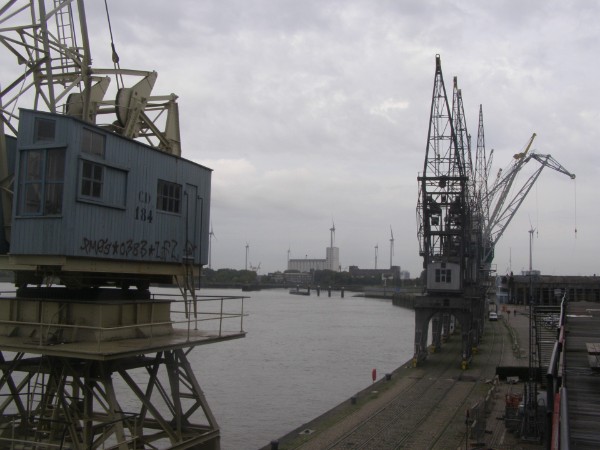
And so where is the IMMC again?
As we already learned, the ocean was too big for a single company to reign it and the end of the IMMC was no real surprise. In 1931, as a much smaller company, they merged with the Roosevelt Steamship Company, founded by Kermit Roosevelt, the grandson of US President Theodore Roosevelt. The new name was the Roosevelt International Marine Company. In the same year, the RIMM bought the financially questionable United States Lines and began to swipe its shippingoperations under this carpet. Atlantic Transport Line was dissolved in 1931 also, American Line merged into United States Lines in 1932, Red Star Line sold in 1934, Baltimore Mail Line merged into United States Lines in 1937, Panama Pacific Line dissolved in 1938 and in the same year American Merchant Line was merged also into United States Lines. In 1940 also the original Roosevelt Line was merged into the United States Lines and in 1943 finally, the company just adopted that name and started operating as United States Lines afterwards, ending all other names. As such, they became the American-flagged and hugely subsidized American answer to the reign of the European lines on the North Atlantic. With America now being a superpower, they had several ways to show their might. One was militairy, especailly comparing themselves to the Sovjet Union, one was space-exploration, especially comparing themselves to the Sovjet-Union and one was transatlantic travel, especially comparing themselves to Europe. In 1952, they thus launched the fastest ship ever to sail this route, the mighty 1952-built and appropriately named United States. Never built for making money, she did just that. A huge moneydrainer for the company and they were probably glad to end her services in 1969 when all transatlantic lines started to face hard times. Unable to place her in the lucrative, American-based cruisetrades, United States Lines withdrew from passengerservices in total.
But it was not their end, as their freightoperations were quite successfull. In 1978, the company was bought by containerization-pioneer Malcolm McLean and in the beginning of the 1980's, the company owned some 43 containerships becoming again one of the international shippingleaders. They then also bought Moore-McCormack Lines and Delta Steamship Lines, now also without passengershipping operations. They started to invest heavily in a series of 12 57.000-ton fuel-efficient containerships, the largest cargoships to date, dubbed the Jumbo Econships which were using less fuel but at a price, they were very slow. Also, the world slided down into a fuelcrisis, together with the fall of international freightrates and these huge, costly ships drained the companies financials. In november 1986, the company filed for bankrupcy, finally liquidated in 1992.
In 1989, United States Lines was restructured as Janus Industries Inc, its shares distributed to United States Lines creditors and the court-managed bankrupcy trust fund. The new company then started to invest in a service company for oil, gas and loggingindustries as well as the hotelbusiness, which since 1998 is their only investment. In 1999, the company restructured as Janus Hotels & Resorts, operating hotels in 21 States. So when you are an American reading this in one of those hotelrooms from Janus, remember that those started with a small shippingline operating a barely remembered service between Philadelphia and the Belgian city of Antwerp.

